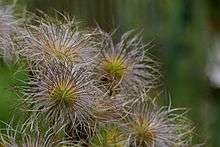Pulsatilla
| Pulsatilla | |
|---|---|
 | |
| Pulsatilla vulgaris | |
| Scientific classification | |
| Kingdom: | Plantae |
| (unranked): | Angiosperms |
| (unranked): | Eudicots |
| Order: | Ranunculales |
| Family: | Ranunculaceae |
| Genus: | Pulsatilla Mill. |
| Species | |
|
See text. | |
The genus Pulsatilla contains about 33 species of herbaceous perennials native to meadows and prairies of North America, Europe, and Asia. Common names include pasque flower (or pasqueflower), wind flower, prairie crocus, Easter Flower, and meadow anemone. Several species are valued ornamentals because of their finely-dissected leaves, solitary bell-shaped flowers, and plumed seed heads. The showy part of the flower consists of sepals, not petals.
The genus Pulsatilla is sometimes considered a subgenus under the genus Anemone or as an informally named "group" within Anemone subgenus Anemone section Pulsatilloides.[1]
The flower blooms early in spring, which leads to the common name Pasque flower, since Pasque refers to Easter (Passover). In South Dakota in the center of North America, the flower sprouts from late March through early June.[2]
Pulsatilla patens is the provincial flower of Manitoba, Canada[3] and (as the synonym P. hirsutissima) is the state flower of the US state of South Dakota.[4] Pulsatilla vulgaris is the County flower for both Hertfordshire and Cambridgeshire in England.[5] Pulsatilla vernalis is the county flower of Oppland, Norway.
Use and toxicity
Pulsatilla is highly toxic, and produces cardiogenic toxins and oxytoxins which slow the heart in humans. Excess use can lead to diarrhea, vomiting and convulsions,[6] hypotension and coma.[7] It has been used as a medicine by Native Americans for centuries. Blackfoot Indians used it to induce abortions and childbirth.[6] Pulsatilla should not be taken during pregnancy nor during lactation.[8]
Extracts of Pulsatilla have been used to treat reproductive problems such as premenstrual syndrome and epididymitis.[8] Additional applications of plant extracts include uses as a sedative and for treating coughs.[8] It is also used as an initial ingredient in homeopathic remedies.[8]


.jpg)
Species
There are about 33 species, including:
|
References
Notes
| Wikimedia Commons has media related to Pulsatilla. |
- ↑ Hoot, S. B., J. D. Palmer, and A. A. Reznicek. 1994. Phylogenetic relationships in Anemone based on morphology and chloroplast DNA variation. Systematic Botany 19: 169-200.
- ↑ "Prairie Pasque". South Dakota Magazine. April 6, 2016. Retrieved April 7, 2016.
- ↑ Government of Manitoba. "Symbols of Manitoba". Archived from the original on 2005-12-10. Retrieved 2011-04-10.
- ↑ Chapter 1 2005 South Dakota Legislative Manual The Mount Rushmore State
- ↑ Plantlife website County Flowers page
- 1 2 Edible and Medicinal plants of the West, Gregory L. Tilford, ISBN 0-87842-359-1
- ↑ Yarnell, E. and Abascal, K. (2001) Botanical Treatments for Depression: Part 2 - Herbal Corrections for Mood Imbalances
- 1 2 3 4 Vaughan, John Griffith; Patricia Ann Judd; David Bellamy (2003). The Oxford Book of Health Foods. Oxford University Press. p. 127. ISBN 0-19-850459-4.
Sources
- "Pulsatilla". Integrated Taxonomic Information System.
- Anemone pulsatilla, Wildflowers index, Department of Horticultural Science of NC State University
- Gregory L. Tilford 1997. Edible and Medicinal plants of the West, Mountain Press Publishing ISBN 0-87842-359-1 preview
- - "Pasqueflower (Pulsatilla vulgaris) Local species action plan for Cambridgeshire, 1999"
External links
- Image of Pulsatilla cernua (Thunb.) Spreng.- Flavon's art gallery
.jpg)